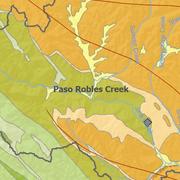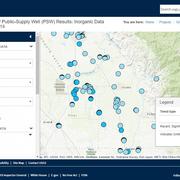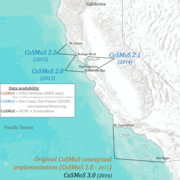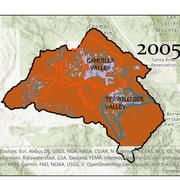Maps
Maps- GIS Data Carousel
GIS Data
USGS is a primary source of geographic information system (GIS) data. Our data and information is presented in spatial and geographic formats, including The National Map, Earth Explorer, GloVIS, LandsatLook, and much more.
Hydrogeology of the Adelaida Area, San Luis Obispo County, CA
The USGS is conducting a comprehensive evaluation of groundwater resources of the Adelaida area. Use this map to explore the hydrogeology of the area, including land use, geology, and USGS hydrologic data by watershed or water management district.
Hydrologic Unit Maps
The U.S. is sub-divided into successively smaller hydrologic units which are classified into four levels: regions, sub-regions, accounting units, and cataloging units. Each unit is identified by a unique hydrologic unit code (HUC) consisting of two to eight digits based on its classification. This site provides information and data for current and historical hydrologic units, names, and numbers.
USGS Hydrologic Conditions Network for New York
Hydrologic Conditions Network Map displays Streamflow Monitoring Network, Groundwater Bedrock Aquifer Monitoring Wells, and Groundwater Unconsolidated Aquifer Monitoring Wells in New York State Drought Regions.
GIS shapefile: Sarasota County, Florida irrigated agricultural land-use for the 2018 growing season
This data set consists of a detailed digital map of individual irrigated fields and a summary of the irrigated acreage for the 2018 growing season developed for Sarasota County, Florida. Selected attribute data that include crop type, irrigation system, and primary water source were collected for each irrigated field.
GIS shapefile: Citrus, Hernando, Pasco, and Sumter Counties, Florida irrigated agricultural land-use from January through December 2019
This data set consists of a detailed digital map of the extent of fields and a summary of the irrigated acreage for the period between January and December 2019 compiled for Citrus, Hernando, Pasco, and Sumter Counties, Florida. Attributes for each field include a general or specific crop type, irrigation system, and primary water source.
Public-Supply Well Water Quality Results: Inorganic Data and Trends, 1974 - 2014 (California GAMA-PBP)
The GAMA-PBP Public-Supply Well Results data viewer allows the user to visualize and download California water-quality data and trends for1974 - 2014. Groundwater-quality data for 38 inorganic constituents are captured and can be downloaded for individual sites or by grid cell.
CoSMoS Implementation versions
The Coastal Storm Modeling System (CoSMoS) makes detailed predictions (meter-scale) over large geographic scales (100s of kilometers) of storm-induced coastal flooding and erosion for both current and future SLR scenarios, as well as long-term shoreline change and cliff retreat. Several versions of CoSMoS have been implemented for areas of the California coast.
Major surficial aquifer segments in Tompkins County, New York
Major surficial aquifer segments in Tompkins County, New York
Anza Hydrologic Data
A portal for easy access to USGS data collected during hydrogeologic research projects in Anza Valley, CA
Anza Valley Land Use (1934 - 2005)
Compares Anza Valley, CA land use data within the USGS study boundaries for 5 time periods between 1934 and 2005.
U.S. Landslide Inventory
A web-based interactive map with a consistent set of landslide data. The searchable map includes contributions from many local, state, and federal agencies and provides links to the original digital inventory files for further information (wherever available).
Sparrow Modeling North Carolina Watersheds Mapper
The USGS developed the SPARROW (SPAtially Referenced Regressions On Watershed attributes) modeling framework to relate water-quality monitoring data to upstream nutrient and sediment sources and watershed characteristics. The mapper can be used to evaluate alternative hypotheses about the relative importance of various pollutant sources.













